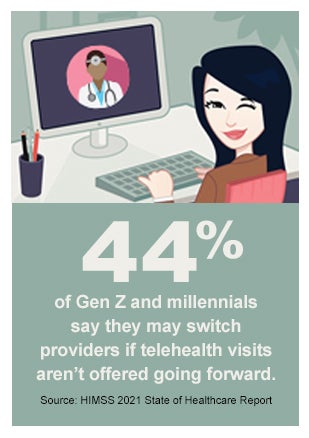

There May Be a Generation Gap in Telehealth’s Future
The pandemic propelled digital health to new heights, with lasting impacts expected. And when it comes to telehealth, convenience appears to be king, according to the HIMSS 2021 State of Healthcare Report.
Nearly two-thirds of patients surveyed in March said they prefer the convenience of telehealth compared with in-office visits. How much that convenience matters in the long run is difficult to say, but clear differences were evident among the generations of respondents.
 More than 70% of younger generations (Gen Z, millennials and Gen X) said they prefer telehealth because of convenience. Gen Z and millennials are resisting a return to in-person care, with 44% saying they may switch providers if telehealth visits aren’t offered going forward. Meanwhile, only a quarter of baby boomer patients prefer telehealth to in-person care.
More than 70% of younger generations (Gen Z, millennials and Gen X) said they prefer telehealth because of convenience. Gen Z and millennials are resisting a return to in-person care, with 44% saying they may switch providers if telehealth visits aren’t offered going forward. Meanwhile, only a quarter of baby boomer patients prefer telehealth to in-person care.
Meanwhile, providers believe utilization of artificial intelligence and machine learning must grow even though 70% of those surveyed had yet to implement specific AI/ML programs.
Operational uses of these technologies, including insurance, cybersecurity and fraud prevention, rank highly among hospitals’ and health systems’ viable AI/ML applications. Providers cited better-focused workloads as an important perceived advantage, the report notes, but respondents were also concerned AI/ML might increase health care inequity and create risks.
Clinicians are overwhelmingly (77%) interested in using AI/ML, but only one in five said they had received training in this area. This presents an opportunity to share information and provide training for clinicians, 52% of whom cited better clinical diagnosis as a top AI benefit.



